Travel News
Culinary Travel: Eat Like a Local, Even If You’re Not One
 Open up a menu, and you’ll often find a bevy of buzzwords surrounding the culinary movement: local, sustainable, fresh, organic.
Open up a menu, and you’ll often find a bevy of buzzwords surrounding the culinary movement: local, sustainable, fresh, organic.
As any savvy traveler knows, you need to take buzzwords with a grain of salt (or pepper, as the case may be).
“The term I like to use is “FLOS,” explains Erik Wolf, president of the International Culinary Tourism Association (ICTA) “It folds in the concepts of eating fresh, local, organic, and seasonal.”
ICTA is a non-profit trade organization that represents professionals in the food, beverage and travel industries, promoting the idea that “the food is the attraction.”
In many cases, Wolf concedes that the growing local movement isn’t easy to maintain. “Sometimes you hear people behind these movements saying that you should eat items that come from only 60-100 miles from home. That’s very difficult. You wouldn’t have coffee or bananas or chocolate!”
But, he explains, the organization promotes the idea of “sourcing within the region.”
Think of it this way: A 1980 study found that the average produce has to travel 1,500 miles from the farm to our plates.
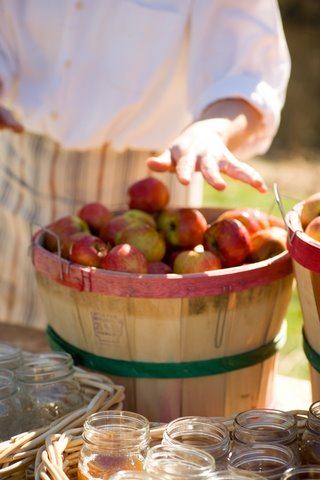 A more recent study came out of Iowa State University’s Leopold Center for Sustainable Agriculture entitled “Food, Fuel and Freeways.” This study compared the distances traveled for locally and regionally grown foods compared with the distances traveled if those food came from outside the state using “conventional” shipping methods (usually semi-trailer trucks).
A more recent study came out of Iowa State University’s Leopold Center for Sustainable Agriculture entitled “Food, Fuel and Freeways.” This study compared the distances traveled for locally and regionally grown foods compared with the distances traveled if those food came from outside the state using “conventional” shipping methods (usually semi-trailer trucks).
According to the study, the average total distance for the three locally sourced meals was 1,198 miles. The same ingredients from conventional sources traveled 12,558 miles.
The study also notes that semi-trailers use more than four times the fuel as “light trucks” used in local transportation. These semis emit almost five times the carbon dioxide as light trucks, while traveling only 1.5 times as far.
And, as expected, shipping from abroad isn’t any better. According to the National Resources Defense Council, in 2006, 44 million gallons of bottled water were imported from Europe and Fiji to New York, and it created nearly 4,000 tons of carbon dioxide … that’s the equivalent of 790 cars in a year!
So really the question is, why not go local if you have the option?
How can you know for sure that your food is coming fresh from a local source, even when you’re traveling? Well, there are a few ways to go about it …
FARM TO TABLE
 Plenty of restaurants claim that their food is “fresh,” but one way to trust that theory is when the food comes straight from a local farm. Even better, how about one in which the chef IS the farmer?
Plenty of restaurants claim that their food is “fresh,” but one way to trust that theory is when the food comes straight from a local farm. Even better, how about one in which the chef IS the farmer?
In Kirkland, Washington, the newly opened Heathman Hotel boasts a true farm-to-table experience. The on-site bar and restaurant, Trellis, is operated by executive chef Brian Scheehser. Chef Scheehser is a farmer who goes out to his own three-acre garden at the South 47 farm to collect his ingredients.
He builds his menu based on what’s fresh and seasonal; one house specialty is the “Chef’s two-hour garden salad,” which he takes quite literally—everything in the salad was plucked from South 47 just two hours prior to meal service. An extensive wine list features wineries in Washington, Oregon and California, while cocktails may feature a sprig of mint or a twist of lime from the garden. 425-284-5900, www.trellisrestaurant.net
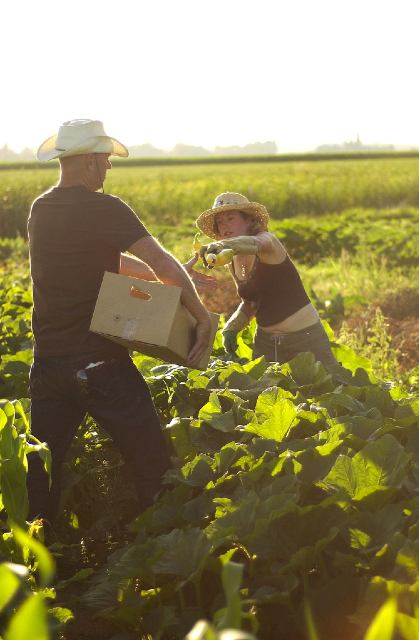 In Walland, Tennessee (about two hours northeast of Chattanooga), Blackberry Farm has long followed the local and seasonal food philosophy. It’s a combination of luxury resort and working farm—you can spend a day in the life of a gardener, toiling in the five-acre organic farm, or learn how to make goat and sheep cheeses with the master cheese maker.
In Walland, Tennessee (about two hours northeast of Chattanooga), Blackberry Farm has long followed the local and seasonal food philosophy. It’s a combination of luxury resort and working farm—you can spend a day in the life of a gardener, toiling in the five-acre organic farm, or learn how to make goat and sheep cheeses with the master cheese maker.
Meals feature fruits, vegetables and herbs plucked fresh from the ground, plus cheese, eggs and honey produced on the farm. Guests can also participate in culinary lessons using farm ingredients; or you can rent out the Farmhouse, a three-bedroom home with a state-of-the-art kitchen, and hire a private chef who will work side-by-side to create your own menu.
Room rates start at $745 a night (two-night minimum), including meals. Farmhouse rates start at $4,800 a night, including meals, and the private chef is an extra $1,000 a day. 865-984-8166, www.blackberryfarm.com
For a crash course in the organic lifestyle, stop by Rosas Farm in Sparr, Florida. Chef Al and his wife Erin are farmers who provide “local, sustainable and organic” products to restaurants and individuals around the country. They welcome visitors to spend a few days on the farm—usually visitors are chefs who are interested in learning about organic cooking, but the invitation is open to any one who is interested in learning how to live and eat sustainably.
Visitors can stay in a guest house that sleeps eight, and Chef Al will offer lessons on how to cook healthy meals with their farm-raised, hormone-free livestock, eggs and produce. And don’t worry, they’re not tofu-thumping enthusiasts—Al and Erin promote the “pragmatic organic” philosophy, meaning that you can take baby steps into the lifestyle. 888-353-9912, www.rosasfarms.com
BRINGING THE TABLE TO THE FARM
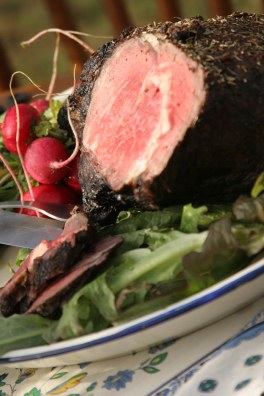 Here’s one way to know that your food is farm-fresh: Eat it right on the farm! Dining at the farm is a growing trend in the local food movement, which usually takes place through the summer and at the height of harvest season.
Here’s one way to know that your food is farm-fresh: Eat it right on the farm! Dining at the farm is a growing trend in the local food movement, which usually takes place through the summer and at the height of harvest season.
In northeast Indiana, Joseph Decuis restaurant hosts a “farm to fork” Organic Wine Dinner and a Harvest Dinner at the establishment’s own 400-acre farm, which is located just about a mile away. Not only do they grow organic vegetables and herbs, and gather eggs daily from the free-range chickens, but they actually raise their own Kobe cattle!
The Organic Wine Dinner takes place each July on the Joseph Decuis farm. Guests can take a tour of the farm before sitting down for an al fresco meal of six courses paired with organic wines. The Harvest Dinner takes place in October, and offers a more casual, Oktoberfest-type experience, pairing each course with imported beer and local microbrews. The wine dinner is $175 per person, and the harvest experience is $100 per person. 260-672-1715, www.josephdecuis.com
Outstanding in the Field dinners is the brainchild of chef Jim Denevan from Gabriella Café in Santa Cruz. He began by hosting dinners at the restaurant, in which local farmers were invited to provide their farm-fresh ingredients and share the spotlight with the chefs. Six years ago, Denevan finally brought his patrons straight to the farm.
Dinners on the farm take place all throughout California, and in recent years, have spread into farms, vineyards and ranches in Colorado, New Hampshire and New York. In 2008, the events are taking place in even more locations across the U.S., and even venturing into South America. There are upcoming dinners this November and December, but they sell out quickly. 831-247-1041, www.outstandinginthefield.com
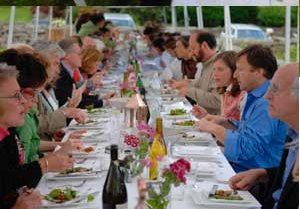 This past summer, a group of Connecticut-based chefs came together to farm-fresh philosophy. Jonathan Rapp of the River Tavern restaurant, Drew McLachlan of Feast Market and Chip Dahlke of Ashlawn Farm hosted Dinners at the Farm, a series of dinners at 10 local farms and vineyards throughout the Connecticut River Valley.
This past summer, a group of Connecticut-based chefs came together to farm-fresh philosophy. Jonathan Rapp of the River Tavern restaurant, Drew McLachlan of Feast Market and Chip Dahlke of Ashlawn Farm hosted Dinners at the Farm, a series of dinners at 10 local farms and vineyards throughout the Connecticut River Valley.
Each meal, with upwards of 150 guests, took place on the fields under a tent. The menus were based on produce, meats and fish that are available from local farmers – from eggplant pizza to peach cobbler. The events are co-hosted by various non-profit organizations, including the Connecticut Slow Food movement and the American Farmland Trust. Each dinner is $85 per person. www.dinnersatthefarm.com
And to round out the cleverly named farm dinners, there is Plate and Pitchfork, based out of Portland, Oregon. Dinners take place on weekends in July and August on farms around the Portland area. Each meal begins with a wine-tasting featuring a guest winemaker, followed by a walking tour of the farm and an al fresco, candlelit dinner prepared by local chefs. The meals are served on white linen tables and are family-style, using ingredients that come straight from the farm. Dinners range from $95 to $115 per person. www.plateandpitchfork.com
CATCH IT, COOK IT, EAT IT
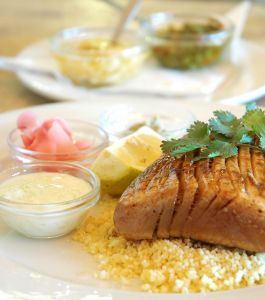 What’s fresher than catching the food yourself?
What’s fresher than catching the food yourself?
In St. Petersburg/Clearwater, Florida, the “locovore” movement isn’t just a trend—it’s been a way of life for generations. This regions sits right on a peninsula, which means that there’s water, water, everywhere, and lots of fish to eat.
But unless you’re an avid angler, chances are that you get past the thrill of catching your own fish, the idea of cleaning and cooking is just plain, fishy. But an increasing number of restaurants in the Clearwater area will cook the fish for you! Just bring it to the restaurant and the chef can clean and prepare your fish.
This “hook and cook” policy long existed in several casual, family-style spots. Check out locations like Ted Peters Famous Smoked Fish, which has been smoking fresh fish for 50 years and The Friendly Fisherman in Madeira Beach where you can literally step off the boat with your catch and into the restaurant. More recently, some upscale restaurants have caught on to the trend: Luna at Hilton Carillon Park Hotel can prepare your fish any way you’d like, from simply broiled to crusted with wasabe topped with a soy-ginger vinaigrette; and Elements Global Cuisine on the Gulfport waterfront will happily cook up your catch of the day.
We asked Erik Wolf of the International Culinary Tourism Association to offer us some tips on how travelers can seek out fresh, local, organic, and sustainable cuisine while on the road. Here’s what he had to say:
GET THE INSIDE SCOOP
One of the easiest things to do is to tap into the knowledge and experiences of friends who live in the destination where you will be traveling. Ask them for a list of the popular or well-respected dining establishments that serve fresh, local food (and not at chain restaurants).
Get their insights into where to shop for cookbooks, cooking gadgets or farm-fresh produce. There’s no substitute for insider information.
THE MILLION-DOLLAR QUESTION
When travelers check into a hotel, we often ask the front desk staff “where’s a good place to eat?” This is the wrong question to ask because it assumes that both you and the front desk staff value the same kind of dining experience. You might be referred to a national chain with the suggestion that you try the onion rings.
Not exactly what you were expecting, was it? If you want a truly good place to eat, ask “Where do the locals eat when they want local specialties?” More often than not, this will be the out of the way hole-in-the-wall spot that culinary travelers love to discover.
SEEK OUT LOCAL FLAVOR
Anyone who would fly from New York City to Miami and order coffee at a place that “proudly serves yet another large national chain coffee” is not a true culinary tourist. Miami has some of the best coffee in the world. True culinary travelers have recognized this and seek out the most popular local places for the area’s delicious Cuban coffee. Same thing applies to looking for Chinese food in Italy, or Italian food in Singapore. Don’t do it!
TAKE A WALK ON THE WILD SIDE
Don’t be afraid to take dining risks. View your trips to new destinations as the opportune time to experience all the area has to offer.
Sink your teeth into Lisbon’s local specialty baccalhau (salted cod) or Tokyo’s yanagawa-nabe, a dish of loach cooked in an earthen pot with gobo (burdock) and dropped eggs. Nothing ventured, nothing gained.
TAP INTO ORGANIZATIONAL “KNOW HOW”
Consult organizations such as the International Culinary Tourism Association (ICTA) for travel and dining suggestions. And keep your eyes out – ICTA is hard at work on Foodtrekker.com, the insider’s guide to the world’s best food and drink experiences, which will launch in January.
Other valuable resources include Slow Food, which publishes informative printed food guides to New York, Chicago and San Francisco, and the Chef’s Collaborative with its new, user-friendly Web site. Both can help you locate artisan producers and local growers all around North America.
By Managing Editor Sarika Chawla for PeterGreenberg.com
Our Culinary Travel section has lots more ideas on great eating experiences.
Or why not indulge your palate in off the beaten path adventures in cities around the world? Check out the Off the Brochure section for more.
Or read more by Sarika Chawla:
Two Years Later, Two Stories of New Orleans
Taking the Slow Boat: Freighter Trips












